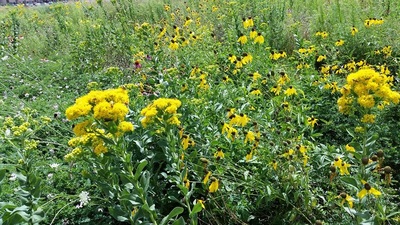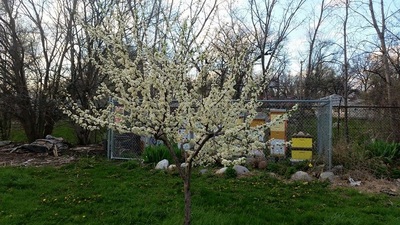|
Just last week, I was picking up a few items at a local farm store, and I noticed they have their live chicks in stock already. For me, this is just a bit early but it made me think it’s a good time to start thinking chickens. We have about 80 chickens at home and have had for several years. We really enjoy the varied personalities of our flock.
A few years ago, in South Bend, when they were considering an Urban Chicken Ordinance we were asked to teach some Chicken classes. Of course, I studied up on my chicken facts. I always like to make sure what your farmer - neighbor tells you is, indeed fact. Since then, we have been teaching about the care of chickens in urban settings for Unity Gardens. During the summer, we even have Unity Gardens’ chickens at the LaSalle Square Unity Garden! So why have Chickens? For us, it is a few different reasons the best one being is they are fun pets. Of course, it also has to do with education; knowing where your food comes from and understanding the interdependence within nature. If you have ever seen pictures of caged chickens you know what I mean. Fresh, free range eggs from your own chickens are much better quality in many ways. If you are a gardener you also know the benefits of chicken manure in the garden. (Make sure to age or compost it.) Chickens can help weed and feed the garden! Before you put chickens into your garden, I like to point out that chickens will also eat your garden. They are great in the garden at the start of the season before you plant, at the end of the season to do clean-up, or during the growing season if you contain them to areas you want weeded. Once you decide to have chickens, there are some basic things you need to get started. First, check the laws where you live to make sure you are allowed to have backyard chickens. If so, you need to first consider safe housing for your chickens. The coop is the chicken’s home. It is where they sleep, lay eggs, and hang out on rainy or cold days. The size of the coop needs to be at least 3-5 square feet per bird according to the University of Minnesota Extension. Your birds will need some basic things in the coop. In order to keep their feet healthy, they require something to perch on; ideally something square that is about 1-1/2 – 2 inches in size. Chickens also need nesting boxes; at least one box for every 4 or 5 chickens, but not less than 2 nesting boxes. There are all sorts of nesting boxes; store bought or homemade. Regardless of which you prefer, it is best to stop at the farm store first to look at what they have and design yours similar to the store bought ones. If you are building your own coop, keep in mind chickens poop on everything! Make sure you incorporate that in your design. Most store bought coops have removable trays for cleaning. As far as flooring goes, a dirt floor with fencing underneath to keep predators out, or a washable tile floor also work well. The coop needs to be predator proof. Raccoons are a real threat in urban areas and they are crafty. A simple latch may not keep them out. There is some more great info on the website backyard chickens regarding chicken coops. The next area to focus on is the run. This is the outdoor area where your chickens hang out all day. The bigger the better! But it is even more important to make the run predator proof. Raccoons and hawks can be a big threat so keeping netting or chicken wire all around, but even on the top helps. With this in mind, the chickens need as much diversity of forage space as you can give them. You will see your chickens looking for bugs, greens, and grit (tiny stones). Chickens do not chew; they grind up food in their gizzard with the grit they pick up. A moveable coop is a good option to keep their area full of fresh greens. Purchasing your chickens is so much fun, but there is a number of considerations. You can buy chicks and chickens online or you can go to a local farm store like Matthy’s Farm Market, Rural King, or Tractor Supply Co. in our area. If you order online, your chicks will come in the mail. You will want to get them out of the packaging as quickly as possible and feed them sugar water in a dropper. New chicks without a mother hen do not know how to eat and this will get them started and energized. Keep baby chicks contained indoors with a heat lamp and sturdy box with wood shavings in the bottom. Chicks need the temperature to be around 80 to 90 degrees. If you notice them huddling below the lamp, it may not be warm enough. Initially they need chick starter feed and fresh water. There are specific feeders designed to assure the babies do not drown, or some people use marbles in a dish of water. Picking chicken breeds can be fun also. What type of bird do you want? One of the most important characteristics is winter hardiness. Besides that, personal preference is your guide. Chicken breeds vary in many ways; meat chickens verses egg layers, egg color and size, bird size, and even temperament. Gently handling birds from and early stage will make most breeds a friend for life. Here are the top five chicken varieties: Rhode Island Reds: These classic hens are a dual-purpose breed; they are both proficient egg layers and the males are large enough to eat (meat birds) Barred Rock is the name of a particular color pattern in the Plymouth Rock breed. These black and white birds are another dual-purpose breed, very hardy and a steady egg layer. They are known for their docile personality. Americana’s have been dubbed “Easter Egg Chickens” because of their lovely eggs, which have shells colored various shades of blue and green. Leghorn hens, a breed originating from Italy, are possibly the best chicken to have for overall egg production and efficiency. Orphington chickens hail from England, and are another dual-purpose bird as they get large enough for meat purposes but also produce friendly hens that lay brown eggs in abundance. Depending on the breed, chickens will start laying in about 6 months. They can produce about 270 eggs a year in their prime under good conditions. After they are about 2 years old, they will decline in production, but will still produce. Slowly they will stop producing but can live for several years longer. Eggs are laid as part of the normal chicken ovulation cycle, so they do not need a rooster in order to produce. Once the chicks are feathered out and the outside temperatures are warmer, (mid-May), you can move them outside for the day, then longer as night temperatures remain consistently warm. This will help get them used to foraging. As they progress to adult feed, a good layer feed will get them what they need. This is especially important if you do not have ample space for them to roam in. You can add some cracked corn and food scraps as treats. They should not be fed meat, junk food, avocadoes, potatoes, and citrus fruits. Chickens can be fun for the whole family, and they are comparatively inexpensive to keep. There are several websites that make good resources, like backyard chickens or your local extension website. Also watch Unity Gardens website for upcoming chicken classes! www.theunitygardens.org
1 Comment
 For years " Gardening 101 " meant Rototill your garden, rake it out, plant rows of your favorite vegetables. The next year repeat the same thing all over again. Farmers do the same thing on a larger scale. As urban area grew we removed the native flora and replaced it with grass which in my book has no value to our ecosystem but its pretty. We cut down native trees and imported flowering trees from other countries that just did not belong. The result was a shift in the balance of our ecosystem. Native trees and wildflowers host beneficial insects. What are beneficial insects ? Lets start with insects in general 99% of all insects are not bad for us or our garden. Even spiders play a role in protecting your home and garden from invaders. A small amount of insects are damaging to our gardens and they in general focus on just one type of plant. In other words squash bugs love plants in the squash family, but you won't see them on tomatoes or anything else. Many of the other 99% of the insects are what we call beneficial's. In other words they feed on the bad bugs. So each time we use any pesticide be it conventional or organic you run the risk of killing as many beneficial's as you do the bad bugs. The use of pesticides and the stripping down of native habitats with grass and parking lots has reduced the population of beneficial's. These beneficial's need the same things we do to survive air, food, water, and shelter. Native plants so its time to think about creating a balanced urban ecosystem, and of course we can only hope farmers do the same. The good news is that more and more farmers are. First off it is a little complex but well worth it. There will be some pain as you make the change. First of all you are going to have to trust the plan. Early on you will be hand picking bugs off and maybe suffering more crop damage then you are comfortable with. Remember those bad bugs are also part of what attracts the good bugs to the garden. Oh which brings up another point you have to learn to live with some of those bad guys because they are food for the good guys, but trust me the population will be low. Lets get started by remembering your yard and garden are one big ecosystem what you do in your yard affects your garden. 1. Plan on planting 25%or more of your yard in native wildflowers, trees and shrubs. Native our best because the are already adapted to the area, which means less water, and fertilizer. These plants will provide food for the beneficial's in the form of pollen and nectar. Many of the non native plants have been bred for showiness but they provide less pollen and nectar. The key is to make sure to have something blooming all season long. This takes some planning. A couple great places to start are Cardno/JFNew and the Xerces Society Its worth downloading this Fact Sheet from the Xerces Society 2. Don't clean-up too much. Mulch, brush, and leaf litter are great places for beneficial's to hang out so maybe leave a brush pile around, and some leaves. Many insects make their homes in the soil so some bare patches of loose soil will also help. 3. Provide water. Take a bird bath fill it with sand and rocks and keep it full of water so the sand and rocks stay wet. Create some areas where water can pool. 4. Make a shelter. This can be done in several ways. Build a insect hotel this can be done with materials you find even pallets. Its all about building nooks and crannies for insects to live. So as you start planning your Spring start making some long lasting changes, start building your own Urban Ecosystem. |
ContributorsWe love to feature blogs from all of the members of our team, including core staff, interns, volunteers, and others. We hope you enjoy the stories and find the information useful! Archives
January 2023
Categories |
AddressLaSalle Square
3701 Prast Blvd. South Bend, IN. 46628 |
Hours
Garden: always Welcome Center Mon-Sun: 9am-7:30pm |
Telephone574-222-2266
After Hours: 574-315-4361 |
Unity Gardens
PO Box 10022 South Bend, IN. 46680 |








 RSS Feed
RSS Feed